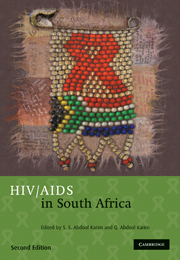Book contents
- Frontmatter
- Contents
- List of Contributors
- Foreword: Peter Piot
- Foreword: Nelson R Mandela
- Acknowledgements
- Section 1 Birth of a rapidly growing epidemic
- Section 2 The virus, the human host and their interactions
- Section 3 HIV risk factors and prevention strategiess
- 9 Reducing sexual risk behaviours: theory and research, successes and challenges
- 10 Barrier methods
- 11 Mother-to-child transmission (MTCT) of HIV-1
- 12 Sexually transmitted infections
- 13 Safe blood supplies
- 14 Intravenous drug use in South Africa
- 15 Positive prevention interventions
- 16 New prevention strategies under development and investigation
- Section 4 Focal groups for understanding the HIV epidemic
- Section 5 The impact of AIDS
- Section 6 Treating HIV
- Section 7 What does the future hold?
- Index
9 - Reducing sexual risk behaviours: theory and research, successes and challenges
Published online by Cambridge University Press: 07 September 2011
- Frontmatter
- Contents
- List of Contributors
- Foreword: Peter Piot
- Foreword: Nelson R Mandela
- Acknowledgements
- Section 1 Birth of a rapidly growing epidemic
- Section 2 The virus, the human host and their interactions
- Section 3 HIV risk factors and prevention strategiess
- 9 Reducing sexual risk behaviours: theory and research, successes and challenges
- 10 Barrier methods
- 11 Mother-to-child transmission (MTCT) of HIV-1
- 12 Sexually transmitted infections
- 13 Safe blood supplies
- 14 Intravenous drug use in South Africa
- 15 Positive prevention interventions
- 16 New prevention strategies under development and investigation
- Section 4 Focal groups for understanding the HIV epidemic
- Section 5 The impact of AIDS
- Section 6 Treating HIV
- Section 7 What does the future hold?
- Index
Summary
SEXUAL BEHAVIOUR IS THE main driver of the South African HIV epidemic. Young South Africans begin to be sexually active between the ages of 12 to 14, and 11% of males and 6% of females have had their sexual debut before the age of 16 years. Among sexually active men aged 15 to 24 years, 31% reported multiple partners in the preceding 12 months. Among sexually active women and men, condoms were not used in up to 40% of the most recent incidents of sexual intercourse. Sexual behaviour is shaped by personal, interpersonal, environmental, cultural and structural forces. The personal factors influencing sexual risk behaviour include feelings and cognitions related to sexuality, HIV/AIDS, and the self. Factors related to interpersonal relationships, such as negotiating condom use, coercive male dominated sexual partnerships and peer pressure to be sexually active, are also important. Cultural factors, such as traditions, shared beliefs, and the norms of the larger society, also play a role. Unfortunately, these often support an unequal distribution of sexual power between men and women and subordinate women's needs and rights. Structural factors, such as the legal, political and economic elements of society also have an important influence on sexual behaviour.
‘Mothusimpilo’, ‘image’ and ‘Stepping Stones’ are three South African hiv prevention projects that addressed the personal, social, economic and political forces that cause and maintain the hiv epidemic.
- Type
- Chapter
- Information
- HIV/AIDS in South Africa , pp. 157 - 182Publisher: Cambridge University PressPrint publication year: 2010
- 1
- Cited by

